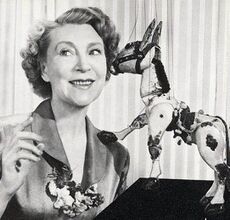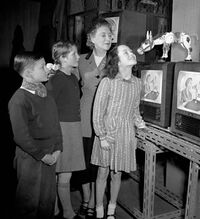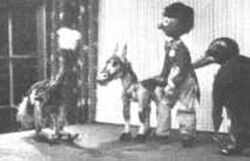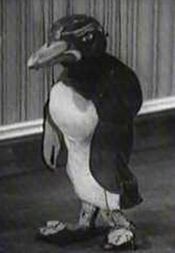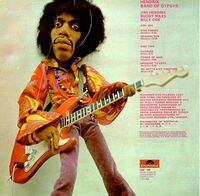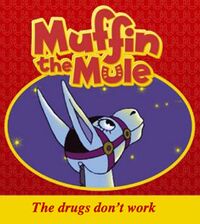Muffin the Mule
“We want Muffin, Muffin the Mule. Children, bring out your clean spoons and candles.”
“I need to go to the bathroom. I may be some time.”
Muffin the Mule was a British children's programme first broadcast on the BBC in 1946, that is now forever tainted with allegations that it was a clever propaganda tool for South American drug cartels to smuggle cocaine into Europe. The show's supposed "innocence" was later said to be a cruel lie to deceive children into accepting the weird antics of a stringed puppet as natural. Nearly all copies of Muffin's shows were later destroyed or dumped in the River Thames to save British television further embarrassment.[1]
Origins
The show was first aired on the BBC in 1946 as an antidote to the Second World War and the subsequent Nuremberg Trials. There was a need to "return to innocent fun" and Muffin was available. He was a wooden marionette mule, the supposed progeny of a rocking horse and stuffed a Spanish toy donkey.[2]
Muffin's "madcap hoofing about" was explained by "distorted carrots" or "hot parsnips" but they also looked suspiciously like reactions to to an accidental drug overdose. Muffin didn't talk but would whisper his wants into the ear of his co-host, the stiffly-coiffured actress Annette Mills (sister of British actor Sir John Mills). She would say "Muffin wants to dance" or "Muffin needs a drink," then Muffin would dance like a loon and flop down, in a loose-stringed heap. Parents loved the show as Muffin was said to calm down children before they were sent upstairs to bed and locked in for the next 14 hours. The show was similar to other TV puppet shows like Howdy Doody on American television and all Italian politicians since Mussolini.
Muffin wasn't alone on the show. There were plenty of other highly-strung puppets to see. There was the faintly sinister Peregrine the Penguin, who seemed to have some authority in the group (and had South American connections). There was also Pablo the Escobar (though no one knew what an "Escobar" was), Oswald the Ostrich, and Wally the Gog, a black-faced marionette with supposed African-American connections.[3] Children accepted Muffin and his gang, not suspecting the rather trippy jumping about was anything but pure entertainment for young children.
The Show
For ten years Muffin held sway in children's hearts. In schoolyards and playgrounds, everyone wanted to be a "Muffin the Mule". Then the rumour got out that Muffin's crazy antics were to do with something he was given everyday in his oats. He was the first "Puppet Dope Friend Shock",[4] as the allegation went. Later on Muffin the Mule and his friends went on tour, the bucking bronco becoming a particular favourite in Colombia.[5]
In retrospect, Muffin's popularity in Colombia and throughout South America, where he was known as "Los Anglos Muffin", might have set off alarm bells. The BBC unwittingly sold the show to countries where the activities of the "giddy ass" were interpreted very differently. Criminal gangs saw a marketing opportunity and Muffin was showing them the way in. Soon a steady stream of "Muffin the Mule" fans would come by boat to Southampton, carrying their "Muffin toys". It was only when these were inspected that it was revealed that there was something unusual about their contents.
Now Muffin's on-screen behavior had a ready made explanation.[6] The show was taken off air in 1955 and shortly after, Annette Mills died. As conspiracy theories were not so widespread then, the two events were not linked at the time. Muffin carried on for another year before the whiff of drugs and other unsavoury rumours ended his television career. He was removed from his celebrity stable and placed in the padlocked BBC toy box. And there he stayed for the next 50 years, forgotten and unable to defend his reputation.
Songs
“From Stardust to Sawdust: The Decline and Fall of Muffin the Mule”
The show's signature tune was "We Want Muffin, Muffin the Mule", sung by Annette Mills with Muffin tap-dancing on his wooden hooves. Other songs on the show included "Muffin Rumba" and "Asinine Arriba !Arriba!!". Oswald and Peregrine usually performed in the other numbers whilst the then-innocently monikered Crumpet the Clown would bellow, "Giving My Sweets to Hungry Suckers" without a hint of innuendo. He would then burst into floods of tears and only Muffin's manic "giddy-ups" would shake Crumpet's incipient manic depressive mood.
The coolest "puppet dude" in Muffin's ensemble was Wally the Gog. Wally's background was always something of a mystery and his name had all the hallmarks of 1950s political correctness. Already a handy guitarist, Wally preferred to stay out of shot, lying on his back with "articulation problems". He later left the show before Muffin's fall and was alleged to have resurfaced as Jimi Hendrix ten years later. Like many stories associated with Muffin the Mule, the truth was subsequently cremated, but there is a "puppet photo" of Hendrix which perhaps hints to his earlier career as Wally.[7]
Personal life
“You're a Voodoo Mule.”
Muffin was romantically linked (via a frisky saddle) to a young Lady Penelope Creighton-Ward.[8] Although no stranger to the exotic cigarette, Muffin's fall from grace persuaded him to move out of the stable and join the cast of Thunderbirds. Elsewhere, attempts to pair Muffin off with other equines also failed until he accepted that his only purpose in life was to make children happy and act as a drugs conduit when the call came.[9]
Retrospective Blame
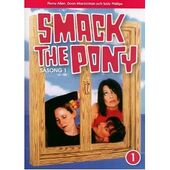
Many years later, people worried about the decline of Western civilisation began to look at the "cultural origins of the drug issue" and blamed Muffin the Mule retrospectively (and others like The Flowerpower Men and Pinky & Pervvy). Muffin, they said, was really "Mafia the Mule" or "Don Muffinioso". Thus a lot of surviving Muffin memorabilia was deliberately destroyed to prevent further drug jokes about the faded TV star.[10]
Smack the Pony and Muffin the Mule
Contrary to expectations, a British television show titled Smack the Pony wasn't about a horse puppet called Smack nor did it feature anything on a string. It did include a lot of other "Muffin-style" humour, with female masturbation and the inadequacies of men chief among its sources of comedy. Requests by children for "Smack Ponies for Christmas" soon led to the show's eventual cancellation after six years.[11]
It wasn't until 2005 that Muffin was finally allowed outside his toy box of shame (but wearing an electronic tag) for a new television series. All his old friends were back except Wally the Gog, who had died from ingesting too many wood chips in 1970.[12] Peregrine and Oswald did reappear, their performance in the episode "Cold Turkey Farm" received a BAFTA nomination in 2007. Muffin's acting was overlooked and there was criticism that he was "no longer funny unless you had been mentally stuck to a ceiling all afternoon."[13] The show wasn't re-commissioned and Muffin was sent back to the box.
References
- ↑ Until the posthumous Jimmy Savile sex scandal in October 2012.
- ↑ Radio Times, 1946.
- ↑ In Seattle
- ↑ Daily Marionette headline, 7th November 1955.
- ↑ Muffin the Mule had been sold to the TV stations as part of a package including I Love Lucy and Batista!, a Cuban drama about the casino business in Havana.
- ↑ Originally thought to be the result of wood alcohol poisoning. Then a letter was sent...
- ↑ Other song clues to the Wally/Jimi career convergence are still being looked into by the experienced musicologists.
- ↑ Diary of Muffin's Girl (Dobbin Press). Chapter 3, paragraph about "Muff Diving".
- ↑ Of course this is all hypothetical, as nothing was proved at the time.
- ↑ Oddly, it was only in the drug heartlands that Muffin was still held in high regard. Later on drug couriers would be known as "Muffins" or "Mules" in memory of the funny little marionette.
- ↑ This came too late for some television stations who bought Smack the Pony unaware it was unsuitable and unfunny for all audiences, regardless of age or gender.
- ↑ See Jimi Hendrix.
- ↑ Leaked memo assessing Muffin's comeback
See also
- Howdy Doody for a similar take but told from an American point of view.
| Featured version: 23 November 2012 | |
| This article has been featured on the main page. — You can vote for or nominate your favourite articles at Uncyclopedia:VFH. | |
